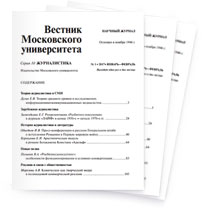Film and TV: What is the Difference?
Download paperResearcher at the Chair of Television and Radio, Faculty of Journalism, Lomonosov Moscow State University, Moscow, Russia
e-mail: s_a_filippov@mail.ruSection: Television and Radio
Film and TV have one fundamental similarity — both of them are flat visual media with the mutual language, — and they have dozens distinctions. Nowadays, many of the distinctions are eliminated, including the technological basis, economical disunion, and some of the aesthetical means. This faces us with the necessity of new differential definition of both media, because the old one, based on the technology, is out of date. The paper discusses the most significant distinctions (derivedfrom Russian theoretical issues), including screen size, place of the exhibition, privacy, artistic and media statuses, intimacy, involving, the presence effect, the direct address to the viewer, the quantity of genres, etc. The author argues that almost all distinctions are the consequences of exhibition’s place: cinema associates with the especial screening house, while TV — with the viewer’s home. Thus, cinema is that is intended for the theatre, and TV— is that is intended for home.
References:
Bagirov E. G. (1978) Ocherki teorii televideniya [Studies of Television Theory]. Moscow: Iskusstvo Publ. (In Russian)
Filippov S. (2003) Bez granits. Perspektivy razvitiya kinoyazyka [Without Borders: The Perspectives of the Evolution of Film Language]. In Sredstva massovoy kommunikatsii v khudozhestvennoy kul‘ture Rossii XX veka. Tom 4 [Mass Media in Russian Artistic Culture of XX Century. Vol. IV]. Moscow: Gosudarstvennyy institut iskusstvoznaniya. Pp. 217–254. (In Russian)
Furduev V. (1929) Kino zavtra [Film of Tomorrow]. Moscow, Leningrad: Moskovskiy rabochiy Publ. (In Russian)
Il’in R. (1973) Izobrazitel‘nye resursy ekrana [The Visual Resources of Screen]. Moscow: Iskusstvo Publ. (In Russian)
Khotinov V. (1965) Vneshnee skhodstvo ili krovnoe rodstvo [The Formal Resemblance or the Blood Relationship]. Iskusstvo kino 8: 84–86. (In Russian)
Kopylova R. (1977) Kinematograf plyus televidenie. Fakty i suzhdeniya [Motion Pictures Plus Television]. Moscow: Iskusstvo Publ. (In Russian)
Mezhov E. (1966) A sushchestvuet li telefil’m? [Does the TV Film Really Exist?]. Iskusstvo kino 12: 35–39. (In Russian)
Mikhalkovich V. I. (1986) Izobrazitel’nyy yazyk sredstv massovoy kommunikatsii [The Visual Language of Mass Media]. Moscow: Nauka Publ. (In Russian)
Mikhalkovich V. (1995) Kino i televidenie, ili O neskhodstve skhodnogo [Film and Television Or About Dissimilarity of the Simillar] Kinovedcheskie zapiski 26: 43-66. (In Russian)
Mikhalkovich V. I. (1998) O sushchnosti televideniya [On the Television Essence]. Moscow: IPK rabotnikov televideniya i radioveshchaniya. (In Russian)
Muratov S. ((2009)1967) Kino kak raznovidnost’ televideniya [The Cinema as a Sort of Television]. In S. Muratov Televidenie v poiskakh televideniya. Khronika avtorskikh nablyudeniy [Television Searching Television. A Chronicle of the Author’s Observations]. Moscow: Moscow Univ. Publ. Pp. 62–80. (In Russian)
Razlogov K. (1982) Iskusstvo ekrana: problemy vyrazitel‘nosti [The Screen Art: Problems of the Expressiveness]. Moscow: Iskusstvo Publ. (In Russian)
Razlogov K. (2010) Iskusstvo ekrana: ot sinematografa do Interneta [The Screen Art: From Cinematograph to Internet]. Moscow: ROSSPEN Publ. (In Russian)
Vol’fson A. (1961) Maloekrannoe kino [The Smallscreen Cinema]. Iskusstvo kino 5: 84–91. (In Russian)
Yurovskiy A. Ya. (1960) Spetsifika televideniya [The Specificity of Television]. Moscow: Gos. komitet po radioveshchaniyu i televideniyu pri SM SSSR. (In Russian)






